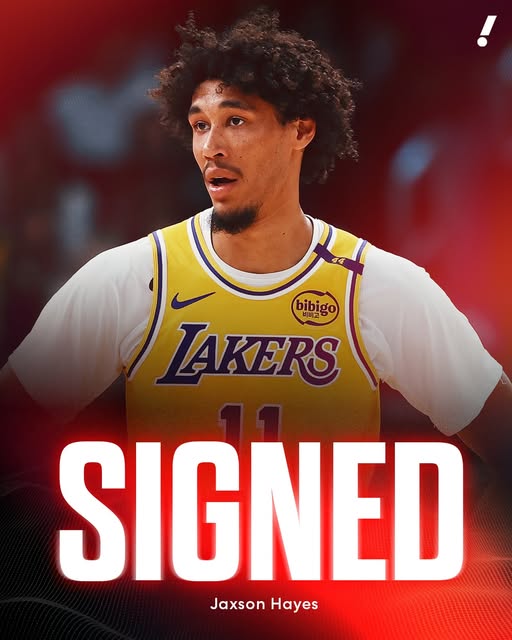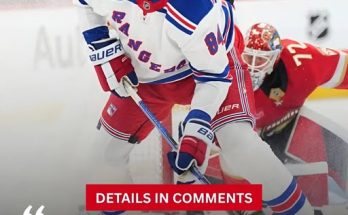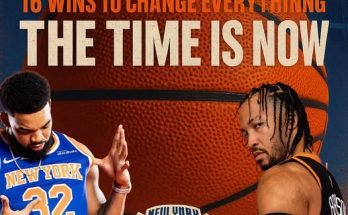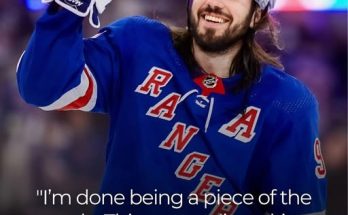Jaxson Hayes has agreed to return to the team on a one-year deal, according to NBA insider Shams Charania. The news marks the second major frontcourt addition by the Lakers within a 48-hour span and signals the franchise’s intent to bolster its interior presence ahead of what is expected to be a highly competitive 2025–26 season. For Hayes, this move represents a continued opportunity to grow within a system that increasingly values his energy, rim protection, and vertical athleticism, while the Lakers gain much-needed depth at the five spot without committing long-term resources.
Hayes’ return is a calculated decision by the Lakers’ front office, which has been carefully navigating a turbulent offseason filled with rumors, trade speculation, and the need to improve a roster that underperformed in key moments last season. Bringing back Hayes on a short-term deal gives the Lakers flexibility while banking on his continued development as a rotational big. The 24-year-old, a former top-10 pick in the 2019 NBA Draft, showed flashes of his potential in limited minutes during the 2024–25 campaign, especially as a lob threat and switchable big man on defense. Though his numbers were modest, his impact was felt in spurts — particularly when anchoring the second unit or stepping in during spot starts necessitated by injury or rest.
In a league that increasingly prizes spacing and versatility, Hayes’ skill set remains valuable. He runs the floor extremely well for his size, provides elite vertical spacing on offense, and possesses enough agility to switch onto smaller players in pick-and-roll scenarios. While still a work in progress in terms of consistent defensive positioning and low-post offensive moves, Hayes has steadily improved his understanding of timing, rotations, and off-ball movement. The Lakers are betting on internal growth and system familiarity to unlock more consistent contributions from him in year two under head coach Darvin Ham’s tutelage.
Hayes’ return also comes at a time when the Lakers are reassessing their long-term direction amid swirling speculation regarding the futures of cornerstone figures like LeBron James and Anthony Davis. With LeBron’s contract status garnering national headlines and rumors suggesting the franchise may be open to eventually moving on from the aging superstar, the front office’s decision to retain younger, athletic talent like Hayes could be indicative of a potential transition period. Hayes fits the mold of a modern big who can plug into multiple lineups and provide minutes regardless of which direction the team ultimately pursues — whether pushing for another title or pivoting toward a retool around Davis and a younger core.
One of the major criticisms of the Lakers last season was their inconsistency on defense and their struggles with rim protection when Davis was off the floor. In those non-AD minutes, the Lakers were routinely out-rebounded, out-muscled, and scored on at will in the paint. Hayes, while not yet an elite shot-blocker, provides a viable second-unit anchor who can contest shots and help close that defensive gap. His motor and effort level also bring much-needed energy, which often sparked brief but crucial momentum swings for the Lakers during the previous season. It’s clear the Lakers saw enough to warrant a second year of investment, albeit on a team-friendly deal that maintains cap flexibility.
From a strategic standpoint, Hayes’ return could also signal changes in how the Lakers intend to manage their frontcourt rotations. Last season, the team frequently played small ball lineups that struggled defensively against larger, more physical opponents. With the addition of another center alongside Hayes — as the Lakers also reportedly signed another big man just days prior — it’s clear the coaching staff may be preparing to shift toward a more traditional lineup structure that allows Davis to play more minutes at the four, where he has historically preferred. Having Hayes back in the fold gives the Lakers more leeway to keep Davis fresh while still protecting the rim, and should reduce the physical toll on their star big man over the course of the season.
Offensively, Hayes is not the type of player who will demand touches or interrupt the flow of a possession-based offense. Instead, his value lies in his ability to finish plays — whether that’s on the receiving end of a pick-and-roll, cutting off-ball for lobs, or cleaning up missed shots with putbacks. In a lineup that includes high-usage players like James, Davis, and potentially another scoring guard, having a low-maintenance big who understands his role is key. Hayes’ willingness to do the dirty work and operate within his limitations is part of what made him an appealing piece to bring back, especially for a team with championship aspirations.
The deal also speaks to the player’s own commitment to growth and belief in the Lakers’ development program. Hayes entered the league with tantalizing physical tools but questions surrounding his motor, discipline, and feel for the game. Over time, and particularly during his stint with the Lakers, there have been encouraging signs of maturity and increased basketball IQ. He appears more grounded defensively, better at recognizing schemes, and more patient on the offensive end. By choosing to return to the Lakers on a one-year deal, Hayes is betting on himself — banking on a breakout season that could put him in position for a more lucrative, multi-year contract next summer, either in L.A. or elsewhere.
For Lakers fans, Hayes’ return provides a familiar face with unfinished business. While he didn’t get heavy minutes last year, those who watched closely saw flashes of the kind of rim-running, shot-contesting presence that could make a difference in high-leverage situations. His ability to mesh with different guard pairings, rotate effectively on defense, and play with high energy is something the Lakers will need, particularly if they aim to weather the storm of a long regular season and position themselves well for a deep playoff run. Chemistry, continuity, and depth all play critical roles in postseason success, and Hayes’ return checks all three boxes.
The broader context of the move also involves the Lakers’ ongoing battle to compete in a loaded Western Conference, where teams like the Denver Nuggets, Minnesota Timberwolves, and Oklahoma City Thunder have all doubled down on size, physicality, and defensive identity. Hayes gives the Lakers a counterbalance to those matchups, and while he won’t be asked to shut down Nikola Jokic or Karl-Anthony Towns single-handedly, he can give the team meaningful minutes to relieve Davis and battle in the trenches when needed. In a conference where every inch matters and depth separates contenders from pretenders, Hayes could be the kind of role player who tips the scales in key moments.
From a salary cap perspective, bringing Hayes back on a one-year deal also keeps the Lakers financially agile. In an offseason where top-tier stars are commanding massive contracts and second-tier players are pushing the market upward, securing a young, athletic big man for a short-term commitment is a shrewd financial move. It gives the Lakers the freedom to pivot if necessary, retain trade flexibility, and maintain a competitive roster without becoming overly locked in to any one path.
Ultimately, the return of Jaxson Hayes is a subtle but significant move for the Lakers. It doesn’t carry the headline-grabbing weight of a blockbuster trade or a superstar signing, but it’s the kind of under-the-radar addition that championship teams rely on. Hayes brings youth, athleticism, and system familiarity to a team that desperately needs durable, consistent contributors in the frontcourt. If he can stay healthy, continue to develop his instincts, and bring relentless energy on both ends of the floor, the Lakers may have landed a key piece at a bargain price — one that could pay dividends when it matters most.



